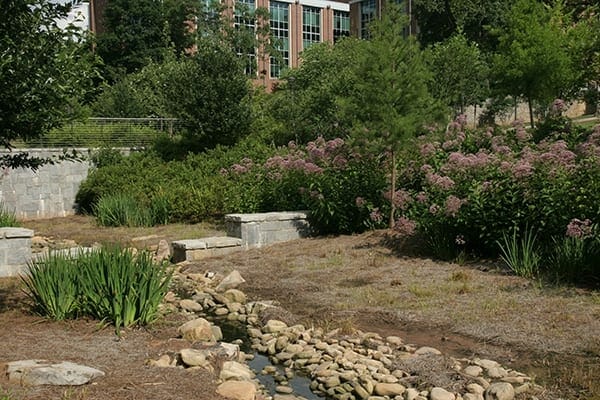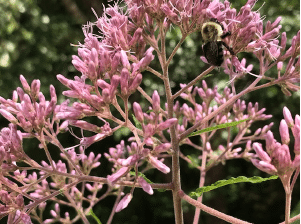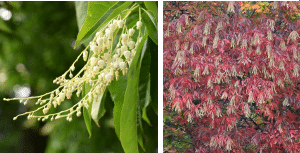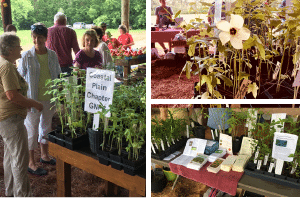Upcoming Events
Don't forget that our July meeting has been canceled. Watch for an announcement about a July field trip where you can see thousands of native plants, carefully landscaped with state-of-the-art storm water management as part of a nationally recognized
sustainability effort. Our next regular meeting will be held at Atlanta
Botanical Gardens on September 11.

Hundreds of Joe Pye plants are just the tip of the iceberg in our surprise July field trip. Watch for details.
Restoration Focus: Heritage Park
Connie Ghosh
Heritage Park is a lovely piece of wooded serenity in south-central Cobb County, created when the East-West Connector, a major roadway, was approved to be built in the 1990's. To mitigate the impact that this new roadway would have on a then-rural area, 122 acres along Nickajack Creek were set aside to serve as a “passive” park dedicated to preservation of the natural setting. A picnic pavilion and parking facilities were built to the west of the creek; a trail and boardwalk were built down to and through a wetland area. After crossing the creek on a sturdy footbridge, the trail turns left and follows the course of the creek north to the ruins of a Civil War mill and to a connection with the Silver Comet trail and the historic Concord Road covered bridge.

By no means are all Heritage Park visitors human! This reminds us that our natural-setting public lands that we enjoy are actually the homes of many species both plant and animal, that would have nowhere to go if natural habitat were not preserved.
Keep Cobb Beautiful developed a special Adopt-A-Mile program for the park, in cooperation with the Cobb Land Trust, and GNPS was awarded the first segment. Under the initial leadership of Julian Deal and Howard DeVane (original GNPS members), a butterfly garden of native plants was established at the trailhead and a section of woods on either side of the trail was cleared of privet. Native plants from GNPS plant rescues were brought to the site and planted. Beautyberry, blueberries, and native azaleas formed the backbone of the original planting. Over the years, ferns, columbines, senecio, obedient plant, phloxes, purple coneflower, oakleaf hydrangea, elderberry, and many other natives were added. This planting project continues to the present day, and the area into which the plants are put has expanded to include the outer edges of the parking lot and the steps to the pavilion. Identifying labels are added to educate the public about native plants, and a large bulletin board in the pavilion is used to provide more extensive information for trail users to see.

Top: The Cobb County parks district provides a dumpster and we fill it with cut privet. Bottom: One recent workday was powered by Youth Villages AmeriCorps.
Also continuing is the privet removal program, which over the course of the years has continued to push back the tide of Chinese privet (Ligustrum sinense) invading the park's wooded areas. Just recently, GNPS volunteers reached the upper floodplain terrace of the creek. This represents a milestone of sorts: over the course of ten years, a party of usually four to six volunteers works once a month for two hours at a time. Sometimes more volunteers show up, and over time the effort has cleared a swath between 50-75 feet wide through a quarter-mile of woods. Specifically, “cleared of privet” means that all privet, from tiny seedlings to full-size trees with trunks of six or more inches in diameter, has been removed. Cut brush is hauled to a dumpster provided by the park. Large privet stumps are painted with herbicide to kill them (no other use of herbicides is allowed, as per stipulation by the original Adopt-a-Mile agreement), and the inevitable re-sprouts are cleared as they occur.
The native understory has recovered as a result. An extensive mayapple colony grows under mature oaks, black walnuts, beeches, bigleaf magnolia, and hop hornbeam; a spicebush thicket graces the slope leading down to the wetland; and a small population of lady's-tresses orchids has been uncovered in a sheltered nook. Along the boardwalk, wingstem grows in a sunny area, and ebony spleenwort is present in the shade. Buttonbush, swamp hibiscus, and sensitive fern grow under the power line that passes over a section of wetland that is kept sunny due to periodic cutting by the power company.
These results have been accomplished by an exceptionally dedicated group of volunteers (supplemented at times by helpful local citizens and various special groups). This group has mastered numerous difficulties and kept on working, challenging an attitude that is still too common in the general community that restoring native habitat to its previous diversity is “an exercise in futility” (as one rather clueless visitor once described it). Native habitats in our communities can and should be restored, but many more volunteers are and will continue to be needed. GNPS members, please help with this vital work, tell everyone about it, and draw in others to help. More information is at the Heritage Park Project web page.
Plant Spotlight: Sourwood
Ellen Honeycutt
Nature puts on a glorious floral display in the spring, but she does save a few things for later, and one of the nicest is the summer show put on by sourwood (Oxydendrum arboreum). In mid-to-late June, elegant sprays of creamy, bell-like flowers open up on plants from 8-30 feet tall. The common name ‘sourwood’ came from the sour tasting leaves, but the flowers bestow another common name: the lily-of-the-valley tree. The show lasts well into July, especially in the North Georgia mountains. The tiny spent flowers can carpet the ground underneath like summer snow.

Left: Oxydendrum arboreum, in bloom. Right: Fall color.
Sourwood was voted by GNPS members as our Plant of the Year in 2004. Native to much of Georgia, this member of the heath family (Ericaceae) is related to some of the most recognized native shrubs and trees: blueberries, azaleas/rhododendrons, and mountain laurel. It can sometimes be found in the nursery trade, stocked by those who recognize its value in the Georgia landscape. If you don’t see it, ask for it! The floral nectar of sourwood is prized by beekeepers as the source of a very tasty run of summer honey, and they are careful to place their hives near the trees during the bloom season. Look for ‘sourwood’ honey at farmers markets.
Not content to wow you with pretty flowers and tasty honey, sourwood fall foliage is one of the most colorful around. Leaf color ranges from soft pink to purple to dark burgundy, often changing color as fall progresses. The tan-colored seed capsules add a lacy look to the fall display. Plant it for any one of these reasons and you’re sure to be happy with your choice.
|
Chapter News: Coastal Plain
Wiregrass Farmers Market
Helene Dutcher
During May, June and July, the Coastal Plain Chapter (CPC) of GNPS has been actively involved in education and conservation through its networking with the Wiregrass Farmers Market at the Georgia Museum of Agriculture in Tifton. The Wiregrass Farmers Market has provided a venue for the CPC to sell donated native plants and provide free educational materials to visitors who come to the market from surrounding areas. Amy Heidt manages the plant sales with the help of local members Bret Wagenhorst, Katherine Melcher, Ellen Corrie, Mary Alice Applegate, Marilynne Marshall, Beth Grant, Heather Brasell, Paul Sumner, Jim Dutcher, and Helene Dutcher.
The native plants on display, with picture placards providing specific information helpful to gardeners, have included: scarlet hibiscus (Hibiscus coccineus); rose mallow (Hibiscus laevis); comfort root (Hibiscus aculeatus); strawberry bush/hearts-a-burstin’ (Euonymus americanus); scarlet sage (Salvia coccinea); obedient plant (Physostegia virginiana); blue mistflower (Conoclinium coelestinum); pepper and salt (Erigenia bulbosa); muhly grass (Muhlenbergia capillaris); river oats (Chasmanthium latifolium); American persimmon (Diospyros virginiana); and pawpaw (Asimina triloba). The CPC volunteers answered questions and provided informational brochures about native plants found in the Coastal Plain.

The Coastal Plains Chapter presence at the Wiregrass Farmers Market features both plants and educational materials.
Rosalynn Carter Butterfly Gardens
Gail Farley and Norris Wootton
“Partnering” with like-minded organizations is an effective way to share knowledge and skills plus accomplish mutual goals. As a long time member and volunteer with Coastal Plain Chapter-GNPS, Norris Wootton (who has just stepped down as treasurer) also volunteers with Dougherty County Master Gardener Extension Volunteers and National Park Service. Wearing three hats, Norris has volunteered many hours on the butterfly garden that is the original site of the Rosalynn Carter Butterfly Trail in Plains, GA. The following was written by Norris. It has been approved by NPS and Cooperative Extension Office and is also posted on the CPC Facebook page with many photographs.

Top: Rosalynn Carter and friends at the garden restoration project. Bottom: Gulf fritillary on salvia and Monarch caterpillar on milkweed.
Early in 2017, the National Park Service responsible for the Jimmy Carter National Historic Site reached out to University of Georgia Extension requesting help from Master Gardener Extension Volunteers (MGEVs) in restoring a butterfly garden in Plains. James Morgan, Extension Coordinator for Dougherty County, gathered a group of interested MGEVs and traveled to Plains to meet with NPS employees and with Mrs. Rosalynn Carter. Mrs. Carter talked at length with the group about her hopes for bringing the garden back to vibrancy. After this meeting, a smaller group planned the butterfly garden and, starting in May, the MGEVs began working twice a month. The butterfly garden is part of the NPS responsibility, but it is not at present open to the public. The MGEVs have to obtain permission from the U.S. Secret Service for each work day. Work will slow down in winter, but the MGEVs have plans to grow some hard-to-find wildflowers from seed to make the garden even more attractive to butterflies and other pollinators next summer. A core group of five volunteers has worked multiple times, but other MGEVs have aided the effort. The MGEVs involved are honored to be allowed to work at this site. They enjoy volunteering both as Extension volunteers and as NPS volunteers. This garden is the original site of the Rosalynn Carter Butterfly Trail which was established by Annette Wise and the Georgia Department of Education. The Rosalynn Carter Butterfly Trail now has hundreds of locations across the United States. The original focus was mostly on Monarchs and the garden has plenty of established milkweed, but all butterflies are welcome.
Fall Plant Sale
Lori Conway and Rita Gowler

The Fall Plant Sale is less than three months away, and information will be updated on the plant sale web page. But now is time to think about volunteering or donating plants. To volunteer, go to the registration page and indicate your preferences. To learn more about donating plants, read on....
Donating Plants for the Fall Plant Sale
Did your Cardinal Flower reseed in the path? Is your New York Fern spreading because of the rainy spring? You can donate your extra native plants to the GNPS Fall Plant Sale, which is Saturday, September 22. Ideally, donated plants should be dug and potted by mid-August, about a month before the sale. This allows them to acclimate and look their best for the sale, so start digging now!
Plant donations can be brought to the Stone Mountain Propagation Project (SMPP) site at Stone Mountain Park. Bring your plants in pots, tubs, or plastic bags. Check the GNPS calendar and come to a propagation workday to help transplant the donations into proper sized pots. If you cannot stay to work, feel free to pick up some pots and the potting mix we prefer, to take home and use for donations.
Native soil is fine, but heavy clay should be modified with soil conditioner. An inexpensive potting medium can be prepared by mixing equal amounts of Home Depot's Timberline soil conditioner or other fine pinebark with Lowe's Evergreen soil conditioner, which has a very fine texture. We are looking for a well-drained medium.
The following plants are especially needed for the sale, but many others are welcome:
Joe Pye weed (any native species)
Lyreleaf sage (Salvia lyrata)
Ironweed (Vernonia angustifolia,
V. noveboracensis)
Penstemon (any native species)
Mouse-ear coreopsis (Coreopis auriculata)
Cardinal flower (Lobelia cardinalis)
White wood aster (Eurybia divaricata)
New York fern (Thelpteris noveboracensis)
Sensitive fern (Onoclea sensibilis)
Netted chain fern (Woodwardia areolata)
Passion vine (Passiflora incarnata)
Green and gold (Chrysogonum viginianum)
Skullcap (Scutallaria incana)
Georgia calamint (Clinipodium georgianum)
Turtlehead (Chelone spp.)
Rudbeckia (Rudbeckia fulgida, R. subtomentosa)
Thank you for donating! Happy Digging!
|